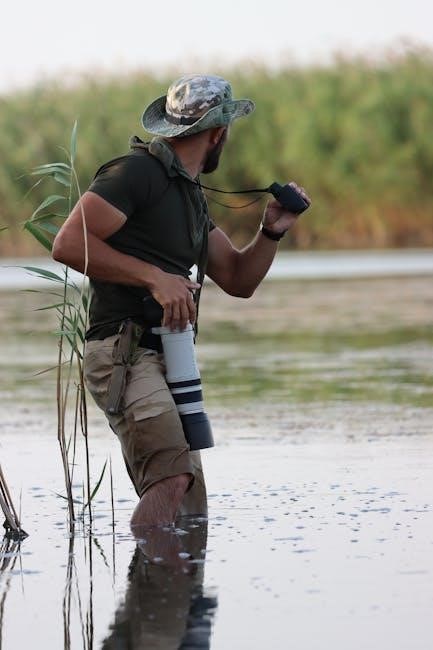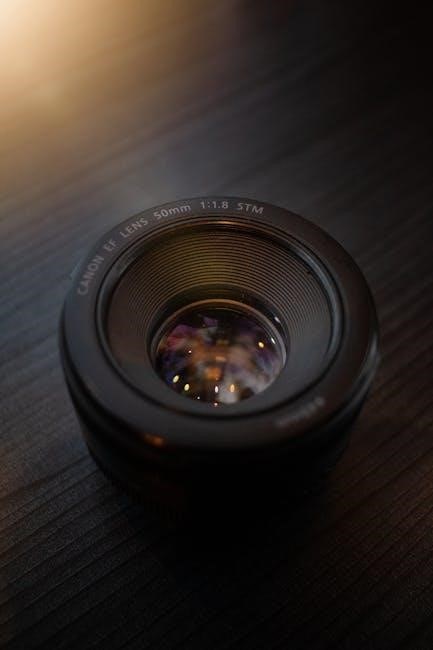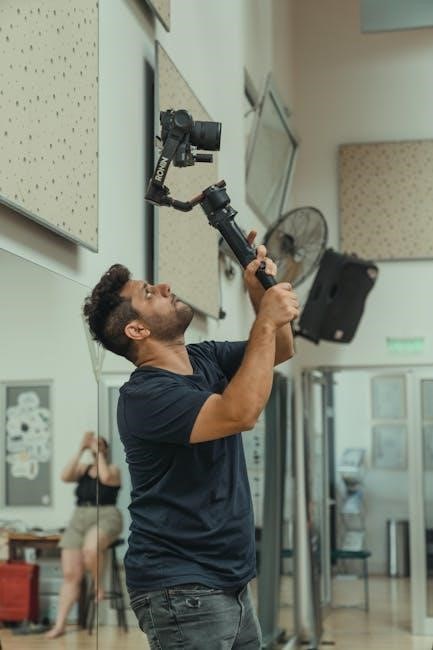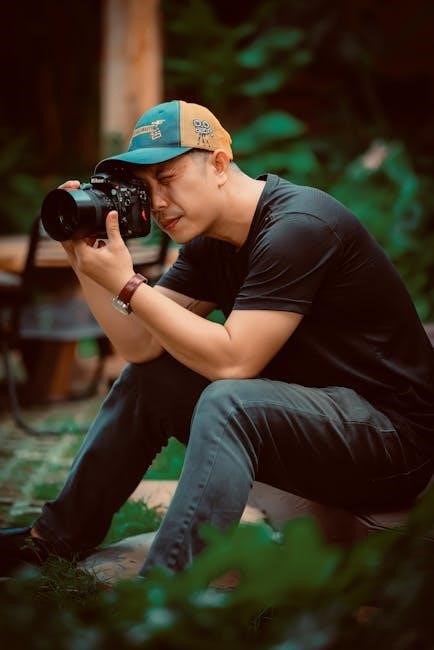
Camera shots are fundamental elements in visual storytelling‚ guiding the audience’s focus and emotions. They help directors convey themes‚ establish mood‚ and highlight details. Understanding shot types‚ angles‚ and framing is essential for effective communication in film and video production.

Types of Camera Shots
Camera shots vary by size‚ angle‚ and framing‚ each serving unique purposes. Common types include Extreme Close-Up‚ Wide Shot‚ Over-the-Shoulder‚ and Medium Shot. These shots help establish context‚ focus attention‚ and convey emotions effectively in storytelling.
Shot Size
Shot size refers to the amount of space a subject occupies within the frame‚ determining the audience’s focus. Common sizes include Extreme Close-Up (ECU)‚ Close-Up (CU)‚ Medium Shot (MS)‚ Wide Shot (WS)‚ and Long Shot (LS). Each size serves a distinct purpose: ECU emphasizes details like eyes or objects‚ while WS and LS provide context‚ showing the environment. Medium Shots balance subject and setting‚ making them ideal for dialogue scenes. Shot size is crucial for composition‚ guiding viewer attention and enhancing storytelling. Proper use ensures clarity and emotional impact‚ helping directors control the narrative’s pacing and mood. Understanding these variations allows filmmakers to convey their vision effectively‚ ensuring each frame communicates the intended message clearly.
Camera Angles
Camera angles are a powerful tool in filmmaking‚ influencing the audience’s emotional response and perception of a scene. They determine how the subject is viewed and can evoke specific feelings or themes. Common angles include high angle‚ low angle‚ eye-level‚ Dutch angle‚ and point of view (POV). A high angle shot‚ taken from above the subject‚ can create a sense of vulnerability or inferiority‚ while a low angle shot‚ framed from below‚ often conveys power or dominance. Eye-level shots establish a neutral perspective‚ making the audience feel equal to the subject. Dutch angles‚ tilted to one side‚ introduce tension or disorientation. POV shots show what a character is seeing‚ immersing the viewer in their experience. Each angle serves a unique purpose‚ allowing directors to guide the narrative and evoke desired emotions. Mastering camera angles enhances visual storytelling‚ ensuring scenes resonate effectively with the audience.
Framing
Framing is the process of composing a shot to guide the viewer’s attention and emphasize specific elements within the scene. It involves carefully selecting what is included or excluded from the frame to create visual balance and focus. Key principles of framing include the rule of thirds‚ leading lines‚ and the use of negative space. The rule of thirds involves placing subjects off-center‚ dividing the frame into thirds both vertically and horizontally‚ to create more dynamic and balanced compositions. Leading lines‚ such as roads‚ paths‚ or patterns‚ help direct the viewer’s eye to the subject. Negative space can be used to isolate the subject or create a sense of simplicity and minimalism. Framing also considers symmetry and the use of natural or man-made features‚ like archways or doorways‚ to enclose the subject. Proper framing enhances storytelling by ensuring the audience focuses on what is most important in the scene; It also contributes to the overall aesthetic and emotional impact of the shot‚ making it a critical aspect of visual storytelling.

Best Practices for Using Camera Shots
Best Practices for Using Camera Shots involve composition‚ lighting‚ and storytelling. These elements collectively enhance visuals‚ convey emotion‚ and guide the viewer’s focus‚ ensuring a compelling narrative experience.
Composition
Composition is a cornerstone of visual storytelling‚ guiding the viewer’s focus and enhancing the emotional impact of a scene. Key techniques include the rule of thirds‚ leading lines‚ framing‚ symmetry‚ and negative space. These elements help create balanced and visually appealing shots. Proper framing ensures the subject stands out‚ while the rule of thirds adds dynamism and avoids a static feel. Leading lines naturally direct the audience’s attention to the focal point. Symmetry and negative space can evoke specific moods‚ from order to isolation. By thoughtfully arranging elements within the frame‚ filmmakers and photographers can convey meaning and evoke emotions‚ making composition essential for effective storytelling in both motion and still imagery.
Lighting
Lighting is a critical aspect of camera shots‚ as it sets the tone‚ creates depth‚ and directs the viewer’s attention. Proper lighting enhances the visual appeal and emotional impact of a scene. Natural light offers authenticity‚ while artificial light provides control over mood and focus. Techniques like backlighting‚ sidelighting‚ and three-point lighting (key‚ fill‚ and backlight) are essential for creating dimension and separating subjects from backgrounds. Soft‚ diffused light minimizes harsh shadows‚ while dramatic lighting emphasizes textures and creates contrast. Lighting setups should align with the scene’s atmosphere‚ whether it’s warm and inviting or cool and tense. Avoid overexposure or underexposure to maintain clarity and detail. Experimenting with lighting angles and intensities can elevate the visual narrative‚ ensuring each shot is both functional and aesthetically pleasing. Effective lighting enhances storytelling by guiding the audience’s eye and evoking the desired emotional response‚ making it a cornerstone of filmmaking and photography.
Storytelling
Storytelling through camera shots is about visually conveying narratives and emotions. Different shots guide the audience’s perspective‚ creating a connection to characters and their experiences. Close-ups highlight emotions‚ while wide shots establish settings‚ immersing viewers in the scene. Angles like low or high shots can convey power dynamics or vulnerability‚ shaping the narrative’s tone. Framing elements focus attention on key details‚ ensuring the story’s message is clear. Lighting enhances mood‚ from warm tones for comfort to stark contrasts for tension. Each shot type—whether extreme close-ups‚ over-the-shoulder shots‚ or point-of-view shots—serves the story‚ revealing character reactions‚ relationships‚ or environmental context. By carefully selecting shots‚ filmmakers craft a visual language that engages and directs the audience’s interpretation; Effective storytelling ensures every frame contributes to the narrative‚ creating a cohesive and impactful experience that resonates emotionally and intellectually.

Choosing the Right Shot for Your Scene
Choosing the right camera shot for your scene is crucial for conveying the intended emotion and narrative. It begins with understanding the purpose of the scene and aligning the shot with its emotional tone. For example‚ close-ups are ideal for capturing intense emotions‚ while wide shots establish context and setting. Over-the-shoulder shots are effective for dialogues‚ creating a sense of intimacy and interaction. Point-of-view shots immerse the audience in a character’s perspective‚ enhancing empathy and engagement. Lighting and framing further refine the shot’s impact‚ guiding the viewer’s focus. Extreme close-ups can emphasize details like expressions or objects‚ while long shots provide a broader view‚ highlighting relationships between characters and their environment. The key is to select shots that serve the story‚ ensuring each frame contributes to the overall narrative. By thoughtfully combining shot types‚ filmmakers create a visually compelling and emotionally resonant experience that draws the audience into the scene.

Importance of Shot Planning
Shot planning is essential for ensuring a film or video production runs smoothly and effectively. It involves carefully selecting and organizing camera shots to align with the story’s vision and objectives. By planning shots in advance‚ directors can maximize filming efficiency‚ reducing time wasted on set and minimizing costly retakes. Shot planning also helps maintain consistency in visual style‚ ensuring continuity in lighting‚ framing‚ and overall aesthetics. It allows filmmakers to visualize the final product‚ making it easier to communicate their creative intent to the crew. Additionally‚ shot planning enhances storytelling by guiding the audience’s focus and emotions. It ensures every frame serves a purpose‚ whether to establish setting‚ convey emotion‚ or build tension. Proper planning also enables filmmakers to experiment with creative techniques‚ such as unique angles or movements‚ without compromising the project’s coherence. Ultimately‚ shot planning is a critical step in translating a script into a compelling visual narrative‚ ensuring the final product resonates with the audience as intended.